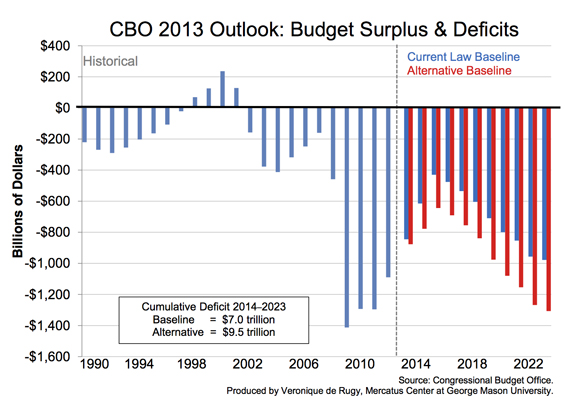- | Government Spending Government Spending
- | Data Visualizations Data Visualizations
- |
Projected Deficits in CBO’s 2013 Budget and Economic Outlook
On February 5, the Congressional Budget Office (CBO) released its Budget and Economic Outlook for fiscal years 2013 to 2023. While the report might suggest the US economy and federal budget are on the road to recovery, such an assessment would be shortsighted.
On February 5, the Congressional Budget Office (CBO) released its Budget and Economic Outlook for fiscal years 2013 to 2023. While the report might suggest the US economy and federal budget are on the road to recovery, such an assessment would be shortsighted.
These charts shows the budget surplus and deficit figures in dollars and as a percentage of gross domestic product (GDP). Its current law baseline scenario, which is used as a yardstick for lawmakers, shows that in 2013 the deficit will continue to decrease as a share of GDP. If the projections materialize, the deficit will drop below $1 trillion to $845 billion for the first time since President Obama took office and will continue to fall for the next two years.

However, if lawmakers were to make changes to current law, such as repealing the sequester cuts that are scheduled to go into effect on March 1, then deficits and debt would be significantly higher than the amounts reported under the current law baseline. The alternative fiscal scenario assumes that most tax provisions that have recently expired or are set to expire are extended as well as other tax and spending policies that differ from those in current law--for example, holding constant Medicare’s payment rates, and undoing the automatic spending reductions. There are also other factors, such as the promised “savings” under the president’s healthcare law, that are accounted for in the CBO baseline.

Under the alternative scenario that assumes such changes to current law, the CBO projects that deficits would shrink less significantly. Also, deficits would rise to $1.3 trillion by 2023 (as opposed to $978 billion in the current baseline) and yield cumulative deficits of $9.5 trillion (as opposed to $7.0 trillion). The debt picture would also get darker. Debt held by the public would reach 87 percent of GDP by the end of 2023 (as opposed to 77 percent).


